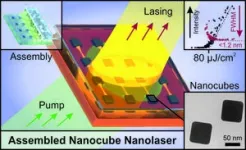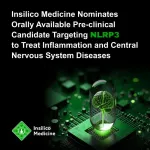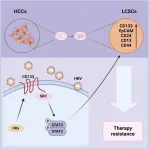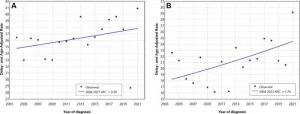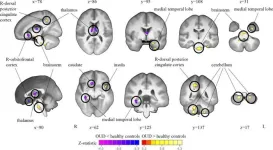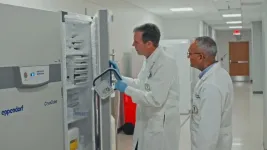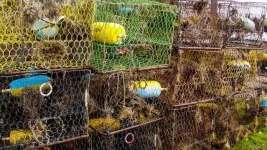(Press-News.org) Kaunas University of Technology (KTU), Lithuania researchers and scientists from Japan have developed a unique nanolaser. Although the dimensions of this laser are so small that its structure can only be seen through a powerful microscope, its potential is vast. With applications in early medical diagnostics, data communication, and security technologies, this invention could also become a key tool for the study of light and matter interactions.
Depending on the application, lasers differ in the way light is amplified and produced, which determines the colour of the radiation and the quality of the laser beam.
“Nanolasers are lasers that use structures a million times smaller than a millimetre to generate and amplify light, and the laser radiation is generated in an extremely tiny volume of material,” says Dr Mindaugas Juodėnas, one of the authors of the invention.
The laser’s operating principle resembles a hall of mirrors
Such nanolasers have been researched and developed for some time. However, KTU scientists’ version is unique in terms of its manufacturing process. It uses silver nanocubes, which are arranged neatly on a surface and filled with an optically active material. This creates the mechanism needed to amplify light and produce the laser effect.
“The silver nanocubes are extremely small, monocrystalline silver particles with excellent optical properties. It is an essential part of the nanolaser we have developed,” says Juodėnas, a researcher at the KTU Institute of Materials Science.
The nanocubes are synthesised using a unique process invented by KTU partners in Japan, ensuring their precise shape and quality. These nanocubes are then arranged into a two-dimensional structure using the nanoparticle self-assembly process. During this process, the particles naturally arrange themselves from a liquid medium into a pre-patterned template.
When the template parameters match the optical properties of the nanocubes, a unique phenomenon called surface lattice resonance is created, allowing efficient light generation in an optically active medium.
While conventional lasers use mirrors to produce this phenomenon, the nanolaser invented by the KTU researchers uses a surface with nanoparticles instead. “When the silver nanocubes are arranged in a periodic pattern, light gets trapped between them. In a way, the process reminds a hall of mirrors in an amusement park, but in our case, the mirrors are the nanocubes and the visitor of the park is light,” explains Juodėnas.
This “trapped” light accumulates until finally the energy threshold for stimulated emission is crossed, producing an intense beam of light with a specific colour and direction. Juodėnas reminds us that the word laser is the acronym for light amplification by stimulated emission of radiation, i.e., the above-described process.
International funding helped develop the idea
By using high-quality, easily produced nanomaterials such as silver nanocubes, the laser requires a record-low amount of energy to operate, allowing the lasers to be mass-produced.
“Chemically synthesised silver nanocubes can be produced in hundreds of millilitres, while their high quality allows us to use nanoparticle self-assembly technology. Even if their arrangement is not perfect, their properties make up for it,” says Juodėnas.
However, at the initial stages the simplicity of the method which should have attracted the interest, instead put Lithuanian research funding agencies off. “Sceptics questioned whether the simple method we were using would be able to create structures of high enough quality for a working nanolaser,” recalls professor Sigitas Tamulevičius.
Strongly believing in the quality of the nanolaser they were developing, the KTU Materials Science Institute team received funding from an international organisation, which, as Juodėnas says, assessed the idea as promising: “After a lot of work and a number of experiments, we have proved that even imperfect arrays can be effective if high-quality nanoparticles are used”.
A neat arrangement of nanoparticles, which is also used in another of KTU researchers’ inventions to create anti-counterfeiting marks, has already received international recognition and has been approved by the US and Japanese patent offices.
In the future, the nanolaser created by KTU researchers could be used as a light source in ultra-sensitive biological sensors for early detection of diseases or real-time monitoring of biological processes. It could also be applied in miniature photonic chips, identification technologies, and authentication devices, where the beam’s unique structure is crucial. Additionally, it could support fundamental research on how light interacts with matter on the nanoscale.
The paper “Lasing in an assembled array of silver nanocubes” is published in Nanoscale Horizons and can be accessed here.
END
KTU scientists developed a nanolaser: silver nanocubes enable light generation
Kaunas University of Technology (KTU), Lithuania researchers and scientists from Japan have developed a unique nanolaser
2024-12-10
ELSE PRESS RELEASES FROM THIS DATE:
Insilico Medicine nominates orally available pre-clinical candidate targeting NLRP3 to treat inflammation and central nervous system diseases
2024-12-10
As the first line against microbial infections or endogenous cellular damage in our body, the innate immune system utilizes NLRs (NOD-like receptors) to sense the molecules triggering microbial infection and damage, thus ensuring the proper immune response function. In the NLRs family, NLRP3 is the most characterized member, and its overactivation can lead to excessive production of pro-inflammatory cytokines and chemokines, driving pathological processes in various inflammatory diseases.
CAMBRIDGE, Mass., Dec 10, 2024 --- Insilico Medicine (“Insilico”), a clinical-stage generative artificial intelligence (AI)-driven drug discovery ...
PLOS receives $3.3 million grant to support Open Access publishing & business model transformation
2024-12-10
SAN FRANCISCO — FOR IMMEDIATE RELEASE
PLOS has been awarded a $3.3million grant from the Bill & Melinda Gates Foundation, underscoring its commitment to pioneer a shift away from traditional publishing models. The 3-year funding package from the Gates Foundation will support PLOS’ transition towards APC-free publishing by enabling authors, funded by the foundation, to publish with PLOS without facing APC barriers, and to contribute to open access publishing options for authors who do not have access to funding. This 3-year grant offers support while PLOS is actively working on new publishing models grounded in open science starting with ...
HBx facilitates drug resistance in hepatocellular carcinoma via CD133-regulated self-renewal of liver cancer stem cells
2024-12-10
Background and Aims
Hepatitis B virus (HBV) infection contributes to hepatocellular carcinoma (HCC) tumorigenesis, drug resistance, and recurrence, although the underlying molecular mechanisms remain unclear. Recent studies suggest that HBV infection may be associated with liver cancer stem cells (LCSCs), but the exact mechanisms are yet to be resolved. In this study, we aimed to analyze the role of HBV infection in regulating the stemness of HCCs, which is closely linked to drug resistance.
Methods
Sphere formation assay and real-time Polymerase Chain Reaction quantification were used to ...
ASN congratulates members for their role in the development of the Scientific Report of the 2025 Dietary Guidelines Advisory Committee
2024-12-10
Rockville, MD – December 10, 2024 –The American Society for Nutrition (ASN) applauds the release of the Scientific Report of the 2025 Dietary Guidelines Advisory Committee (DGAC). The Society is pleased to note that 19 of the 20 Committee members are ASN members, including the Chair, ASN President Sarah Booth, and Vice Chair, Angela Odoms-Young, a member of the ASN Board of Directors. The DGAC is an independent panel of nutrition science experts tasked to review the state of the evidence on nutrition-related topics and scientific questions identified by the U.S. Department of Agriculture (USDA) ...
Late-stage breast cancer diagnosis on the rise in US
2024-12-10
OAK BROOK, Ill. – The number of women with late-stage, invasive breast cancer at the time of diagnosis increased significantly among U.S. women across all ages and ethnicities between 2004 and 2021, according to a study published today in Radiology, a journal of the Radiological Society of North America (RSNA).
In the study, researchers analyzed the latest available Surveillance, Epidemiology, and End Results (SEER) data on annual stage-specific breast cancer incidence rates between 2004 and 2021. SEER data is collected from 22 population-based ...
Brain volume changes seen in opioid users
2024-12-10
OAK BROOK, Ill. – Researchers at the Yale School of Medicine found structural and functional alterations in specific brain regions of individuals with opioid use disorder. The study’s results were published today in Radiology, a journal of the Radiological Society of North America (RSNA).
Opioids are a class of drugs that include synthetic opioids such as fentanyl, prescription pain relievers like oxycodone, and illegal narcotics, including heroin. Opioids have a high potential for misuse, and opioid use is a major contributor to drug overdoses in the ...
Ultra-processed foods may drive colorectal cancer risk, USF-TGH study finds
2024-12-10
Media Contact:
John Dudley
(814) 490-3290 (cell)
jjdudley@usf.edu
EMBARGOED FOR PUBLICATION UNTIL TUESDAY, DEC. 10, AT 10 A.M. ET
TAMPA, Fla. (Embargoed until Dec. 10, 2024) – Colorectal cancer, the second leading cause of cancer-related deaths in the United States, may be fueled by the food on our plates. Researchers at the University of South Florida and Tampa General Hospital Cancer Institute have uncovered a potential link between the Western diet – dominated by ultra-processed foods and unhealthy oils – and the chronic inflammation that drives ...
Two Case Western Reserve University faculty members honored as Fellows of the National Academy of Inventors
2024-12-10
Polymer scientist Gary E. Wnek and stem-cell biologist Arnold Caplan have been named Fellows of the National Academy of Inventors (NAI), the highest professional distinction awarded solely to inventors.
The two Case Western Reserve University faculty members will be inducted June 26 at the NAI’s 14th annual conference in Atlanta. Caplan, who was nominated in 2023, died in January. The NAI said his family will be invited to accept the medal in his honor.
The NAI Fellows Program was established “to highlight academic ...
How this cancer drug could make radiation a slam dunk therapy
2024-12-10
UCSF scientists combine a precision drug therapy with an antibody and radiation to eliminate tumors without causing side effects.
Radiation is one of the most effective ways to kill a tumor. But these therapies are indiscriminate, and they can damage healthy tissues.
Now, UC San Francisco scientists have developed a way to deliver radiation just to cancerous cells. The therapy combines a drug to mark the cancer cells for destruction and a radioactive antibody to kill them.
It wiped out bladder and lung tumors in mice ...
National TRAP Program funds large-scale cleanup of discarded fishing gear
2024-12-10
A massive cleanup of derelict fishing gear in U.S. coastal waters is set to begin now that William & Mary’s Batten School & VIMS has awarded $1.4 million to fund 11 projects under the National Fishing Trap Removal, Assessment, and Prevention (TRAP) Program. From diving in waters up to 130 feet deep to retrieve lobster and crab traps in protected ecosystems to the removal of debris in tribal fishing grounds, this initial round of projects facilitates removal efforts in California, Connecticut, Delaware, Florida, Louisiana, Maine, Maryland, ...
LAST 30 PRESS RELEASES:
Understanding the role of linear ubiquitination in T-tubule biogenesis
Researchers identify urban atmosphere as primary reservoir of microplastics
World’s oldest arrow poison – 60,000-year-old traces reveal early advanced hunting techniques
Bristol scientists discover early sponges were soft
New study uncovers how rice viruses manipulate plant defenses to protect insect vectors
NSF–DOE Vera C. Rubin Observatory spots record-breaking asteroid in pre-survey observations
Ribosomal engineering creates “super-probiotic” bacteria
This self-powered eye tracker harnesses energy from blinking and is as comfortable as everyday glasses
Adverse prenatal exposures linked to higher rates of mental health issues, brain changes in adolescents
Restoring mitochondria shows promise for treating chronic nerve pain
Nature study identifies a molecular switch that controls transitions between single-celled and multicellular forms
USU chemists' CRISPR discovery could lead to single diagnostic test for COVID, flu, RSV
Early hominins from Morocco reveal an African lineage near the root of Homo sapiens
Small chimps, big risks: What chimps show us about our own behavior
We finally know how the most common types of planets are created
Thirty-year risk of cardiovascular disease among healthy women according to clinical thresholds of lipoprotein(a)
Yoga for opioid withdrawal and autonomic regulation
Gene therapy ‘switch’ may offer non-addictive pain relief
Study shows your genes determine how fast your DNA mutates with age
Common brain parasite can infect your immune cells. Here's why that's probably OK
International experts connect infections and aging through cellular senescence
An AI–DFT integrated framework accelerates materials discovery and design
Twist to reshape, shift to transform: Bilayer structure enables multifunctional imaging
CUNY Graduate Center and its academic partners awarded more than $1M by Google.org to advance statewide AI education through the Empire AI consortium
Mount Sinai Health system receives $8.5 million NIH grant renewal to advance research on long-term outcomes in children with congenital heart disease
Researchers develop treatment for advanced prostate cancer that could eliminate severe side effects
Keck Medicine of USC names Christian Pass chief financial officer
Inflatable fabric robotic arm picks apples
MD Anderson and SOPHiA GENETICS announce strategic collaboration to accelerate AI-driven precision oncology
Oil residues can travel over 5,000 miles on ocean debris, study finds
[Press-News.org] KTU scientists developed a nanolaser: silver nanocubes enable light generationKaunas University of Technology (KTU), Lithuania researchers and scientists from Japan have developed a unique nanolaser

